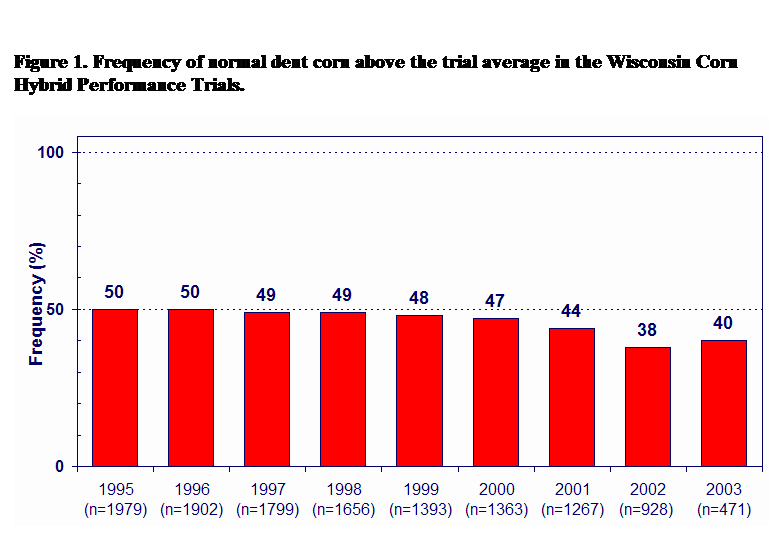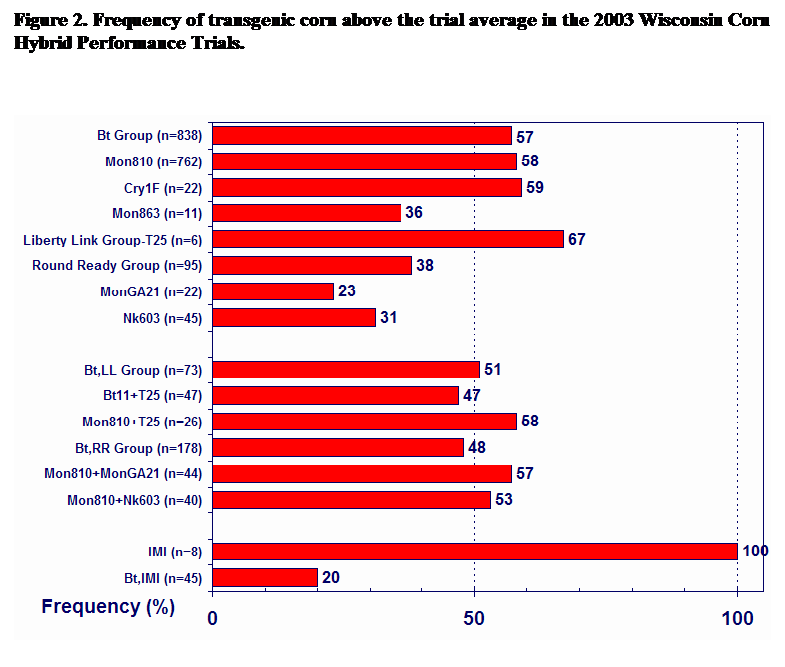
Performance of Transgenic Corn Hybrids in 2003
December 11, 2003 10(27):198-200
Joe Lauer, Corn Agronomist
A recent trend in the UW Corn Performance trials is the lower frequency of normal
dent corn hybrids yielding above the trial average (Figure 1). From 1973 to 1996,
normal dent corn hybrids as a group were distributed around the trial average in
a 50:50 ratio, i.e. 50% of the normal dent corn hybrids were above the trial average
and 50% of the hybrids were below the trial average. Beginning in 1997 and continuing
through 2003 the frequency with which normal dent corn hybrids yield above the trial
average has been decreasing. In 2003 only 40% of the normal dent corn hybrids yielded
above the trial average. There are still quite a few normal dent corn hybrids that
have excellent performance and are the top hybrids in a trial, but greater care
must be used when selecting normal hybrids.
There are at least two possible reasons that might explain this observation. First,
the Bt trait is being incorporated into the best genetics available. Normal dent
corn hybrids are being replaced by hybrids with the Bt trait. For the first time
more transgenic hybrids were entered into the UW Performance trials than normal
hybrids. Most transgenic hybrids that perform well have the Bt-ECB gene (events
Mon810, Bt11, or Cry1F-Hx) incorporated into the hybrid (Figure 2). About 53 to
59% of these hybrids perform above the trial average. When stacked with other traits,
the stacks perform well also, except for Bt,IMI. Other transgenic events including
Roundup Ready (events MonGA21 and Nk603) and Liberty Link (event T25) have had variable
performance over the years.
Another possible reason for greater than expected performance of Bt hybrids is that
low undetected European Corn Borer pressure may exist in the trials and is reducing
the performance of normal dent corn hybrids. The latter reason, although a possibility,
is unlikely since the trials are scouted every 2 to 3 weeks and little ECB damage
is observed.
For the first time this season we evaluated Bt-CRW (event Mon863) hybrids. These
hybrids yielded above the trial average only 36% of the time.
It is imperative that adapted high-performing normal dent corn hybrids remain available
to corn farmers. Refugia of 20% of the corn acreage on a farm is required by EPA
and must be maintained in order for Bt transgenics to continue to be a farm field
tool for controlling ECB. In Wisconsin, 20% of the acreage represents 680,000 acres
that must be planted to normal dent corn (USDA, 2001 Statistics).

